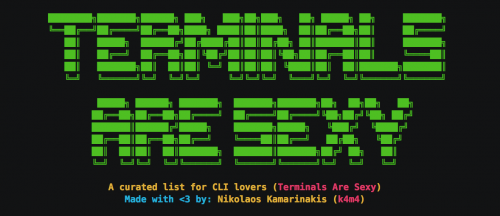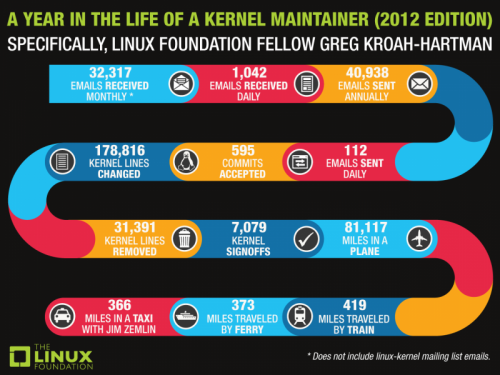Terminals are sexy is a curated list of Terminal frameworks, plugins & resources for CLI lovers. There is plenty of links to applications, plugins and configurations. For me personally, the most useful one was the link to sensible Bash configuration.
Category: Linux
Linux is my primary operating system. I used it on the servers, desktops, laptops, netbooks, and even mobile phones since approximately 1997. I’ve tried a number of distributions over the years, and even created a couple myself. I still look around sometimes to see what others are up to. But most of my machines are running some sort of Red Hat – either a quick and easy Fedora Linux, or a stable and secure Red Hat Enterprise Server, or a cheaper CentOS alternative.
And while by now I am very comfortable in the Linux environment (both graphical and command line), I still discover a lot of new and interesting things about it. When I come across something worthy, I usually share it with the rest of the Open Software world, using this category.
MySQL 8 is coming
OpenSource.com covers the upcoming release of the MySQL 8.
What happened to 6 & 7?
Years ago, before the Sun Microsystems purchase of MySQL AB, there was a version of MySQL with the number 6. Sadly, it was a bit ambitious and the change of ownership left it to wither. The MySQL Cluster product has been using the 7 series for years. With the new changes for MySQL 8, developers feel they have modified it enough to bump the big number.
The new version brings a whole lot of changes to filesystem organization, indexes, faster ALTER TABLE, and more.
i3 window manager – a week later
A week ago I blogged about i3 window manager and my attempt to use it instead of MATE. So, how am I am doing so far?
The long story short: I love i3. It’s awesome. But I still switch back to MATE once in a while.
What’s good about i3? It’s super fast. Even faster than a pretty fast MATE. It’s keyboard navigated, and it only takes about a day to get used to enough keyboard shortcuts to feel comfortable and productive. It’s super efficient. Until I tried i3 I didn’t recognize how much time I spend moving windows around. It is unexcusable amount of time spent needlessly.
What’s bad about i3? It’s low level. In order to make it work right with multiple screens, one need to get really familiar with xrandr, the tool I last used years ago. If you are on a laptop, with a dynamic setup for the second screen (one monitor at the office, one at home, and an occasionally different project at client’s premises), you’ll need a bunch of helper scripts to assist you in quick change between these setups.
And then there is an issue of flickering desktop. The web is full of questions about how to solve a variety of flickering issues when using i3. The one that I see most often is the screen going black once in a while. Sometimes it takes a second to come back, sometimes a few seconds, and sometimes and it doesn’t come back at all. The more windows I have, spread across more workspaces, with more connected monitors – the more often I see the issues. It’s annoying, and it’s difficult to troubleshoot or even report, as I haven’t found a pattern yet, or how to reproduce the problem.
With that said though, I am now about 80% time using i3. I like the simplicity and efficiency of it. It’s so good, that I work better even without a second monitor. But when I do need a second monitor (paired programming, demos, etc), or when I have a projector connected, I switch to MATE. That’s about 20% of my time.
i3 – tiling window manager
In the last few days my attention was unfairly distributed between a whole lot of tasks. The fragmentation and constant context switching affected my productivity, so I briefly revisited my toolbox setup, in hopes to find something that I didn’t know about, forgot about, or have greatly underutilized.
One of the things that came (again) on my radar was terminal multiplexer tmux. I’ve blogged about it before. I used it for a while, but at some point, it faded away from my daily routine. The two most useful features of tmux are:
- Persistent sessions, where you can work on a remote machine, detach your terminal, disconnect from the machine entirely, and then, at some point later, connect again and continue from where you left off. With simpler workloads and reliable Internet connection, this became less useful to me. When I do need this functionality, I use screen, which is more often installed on the machines that I work with.
- Terminal multiplexer, where you can split your terminal screen into a number of panels and work with each one like it’s a separate terminal. This is still useful, but can be done by a number of different tools these days. I use Terminator, which supports both horizontal and vertical screen split. Terminology is another option from a choice of many.
I thought, let me find something that people who used tmux have moved on to. That search led me, among other things, to “ditching tmux” thread on HackerNews, where in the comments a few people were talking about i3 tiling window manager.
Continue reading i3 – tiling window manager
Maintainers Don’t Scale
Daniel Vetter, one of the Linux kernel maintainers, shares some thoughts on why maintainers don’t scale, what it takes to do the job, what has changed recently and what needs to change in the future.
This reminded me of this infographic, which depicts a year (even though back in 2012 – probably much busier these days) for another kernel maintainer – Greg Kroah-Hartman. Note that the number of emails does not include the messages on the Linux kernel mailing list (LKML), which is in its own category of busy:
The Linux kernel mailing list (LKML) is the main electronic mailing list for Linux kernel development, where the majority of the announcements, discussions, debates, and flame wars over the kernel take place. Many other mailing lists exist to discuss the different subsystems and ports of the Linux kernel, but LKML is the principal communication channel among Linux kernel developers. It is a very high-volume list, usually receiving about 1,000 messages each day, most of which are kernel code patches.

